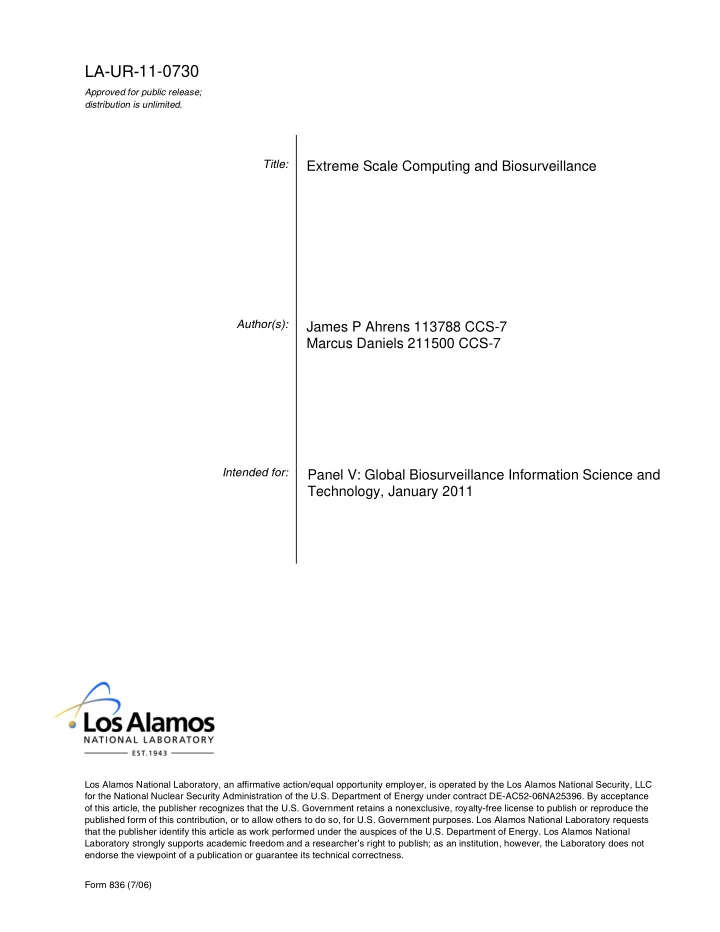

11-0730 LA-UR- Approved for public release; distribution is unlimited. Title: Extreme Scale Computing and Biosurveillance Author(s): James P Ahrens 113788 CCS-7 Marcus Daniels 211500 CCS-7 Intended for: Panel V: Global Biosurveillance Information Science and Technology, January 2011 Los Alamos National Laboratory, an affirmative action/equal opportunity employer, is operated by the Los Alamos National Security, LLC for the National Nuclear Security Administration of the U.S. Department of Energy under contract DE-AC52-06NA25396. By acceptance of this article, the publisher recognizes that the U.S. Government retains a nonexclusive, royalty-free license to publish or reproduce the published form of this contribution, or to allow others to do so, for U.S. Government purposes. Los Alamos National Laboratory requests that the publisher identify this article as work performed under the auspices of the U.S. Department of Energy. Los Alamos National Laboratory strongly supports academic freedom and a researcher’s right to publish; as an institution, however, the Laboratory does not endorse the viewpoint of a publication or guarantee its technical correctness. Form 836 (7/06)
Extreme Scale Computing and Biosurveillance Abstract “The Key finding of the Panel is that there are compelling needs for exascale computing capability to support the DOE’s missions in energy, national security, fundamental sciences, and the environment. The DOE has the necessary assets to initiate a program that would accelerate the development of such capability to meet it’s own needs and by so doing benefit other national interests. Failure to initiate an exascale program could lead to a loss of U.S. competitiveness in several critical technologies.” Trivelpiece Panel Report, January 2010 Our goal for the presentation is to add a new perspective to the Biosurveillance community of how Data-Intensive Computing or Super-Computing approach can contribute to Biosurveillance. No matter through high quality images, quantifying the data error for analysis, qualifying visual error for visualization, intelligent sampling designs to provide more information on less data, in-situ & storage-based sampling-based data reduction and more, these will all benefit the Biosurveillance community in future development and enhance U.S. competitiveness in technology.
James Ahrens and Marcus Daniels Los Alamos National Laboratory Panel V: Global Biosurveillance Information Science and Technology January 2011
10^18 10^15 10^12 10^9 Slide 2
Slide 3
Science of Nonproliferation (similar to biosurveillance requirements) Gather input ▪ Build, design and interpret data from sensors ▪ Uncertainty quantification Model problem ▪ Proliferation process simulation Aggregate simulation results and observations ▪ Data integration Analyze results ▪ Information exploration and analysis ▪ Analyst in the loop ▪ Automated Statistics and machine learning for detecting rare and anomalous behavior Slide 4
Bovine Tuberculosis • Spread through the exchange of respiratory secretions. • Minimal biosecurity at farms, having high density of cattle. Deer can wander in. • TB can survive on feed for many days in a range of temperatures. • Hunt clubs can create conditions leading to high density of deer. • Lab experimentation expensive, requiring Biosafety 3 level labs suitable for wildlife. • Because of this, details on species- specific susceptibilities not well understood.
Required hunting reports Deer kill location accurate to 1 square mile
Tests on harvested deer TB+ buck TB+ doe yields prevalence maps of TB TB- buck TB- doe
Image processing from satellite data yields a deer’s view of the landscape Deer habitat USGS 30 meter shape data land-use codes Therma ( ) = l Cover ( Fall/Winter ) = Habitat ( Spring/Summe ) = r Habitat
Populate the agent simulation Spatially explicit estimate of true populat Harvest density data (location, age, sex, TB +/-) = + Yearling Yearling Adult Adult Buck Doe Buck Doe 1997 10 171 10 100 1998 11 180 14 120 1999 12 150 12 110 2000 13 140 20 140 2001 12 120 8 150 2002 11 110 10 160
Prefix Mega Giga Tera Peta Exa 10 n 10 6 10 9 10 12 10 15 10 18 Displays, Data sizes Technology and machines networks
Numerically-intensive / HPC approach Massive FLOPS ▪ Top 500 list – 1999 Terascale, 2009 Petascale, 2019? Exascale ▪ Roadrunner – First petaflop supercomputer – Opteron, Cell Data-intensive supercomputing (DISC) approach Massive data We are exploring it by necessity for interactive scientific visualization of massive data DISC using a traditional HPC platform
Slide 15
In-situ & storage-based sampling-based data reduction Can work with all data types (structured, unstructured, particle) and most algorithms with little modification Intelligent sampling designs to provide more information in less data Little or no processing with simpler sampling strategies (e.g., pure random) Untransformed data with error bounds Data in the raw; Ease concerns on unknown transformations/alterations Probabilistic data source as a first-class citizen in visualization and analysis Slide 16
Quantify the data error for analysis, quantify visual error for vis Show the data error, allow the user to reduce error incrementally Scientist is always informed of the error in their current view Data size scales with sample size for bottlenecks Any sample sizes based on error constraints and system/human constraints Same model could be used in simulations to reduce data output per time step Slide 17
There are many opportunities for supercomputing in the field of biosurveillance Slide 19
Team: John Support: Patchett Jonathan Los Alamos National Woodring Li-Ta Laboratory – LDRD Lo Susan Cosmology and Mniszewski Patricia sampling project USDA Fasel Joshua Wu Christopher Bovine tuberculosis Project Mitchell Sean DOE Office of Williams Science Climate modeling Slide 20
Recommend
More recommend